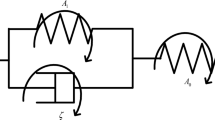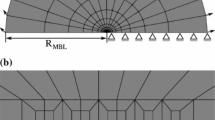Abstract
In this paper, the problem of modeling crack in 2D viscoelastic media is studied using the extended finite element method. The paper focuses on the definition of enrichment functions suitable for cracks assessment in viscoelastic media and the generalized domain integrals used in the determination of crack tip parameters. The opening mode and mixed mode solutions of crack tip fracture problems in viscoelastic media are also undertaken. The results obtained by the proposed method show good agreement with the analytical methods and provide reasonable background information to enhance the modeling of crack growth in viscoelastic media.
Similar content being viewed by others
References
Schapery R A A. Theory of crack initiation and growth in viscoelastic media. I. Theoretical development. Int J Fract, 1975, 11: 141–159
Schapery R A A. Theory of crack initiation and growth in viscoelastic media. II. Approximate methods of analysis. Int J Fract, 1975, 11: 369–388
Claude C, Frédéric D. A new incremental formulation in the time domain for crack initiation in an orthotropic linearly viscoelastic solid. Mech Time-Dependent Mater, 2001, 5: 229–253
Belytschko T, Black T. Elastic crack growth in finite elements with minimal remeshing. Int J Numer Meth Eng, 1999, 45: 601–620
Melenk J M, Babuška I. The partition of unity finite element method: Basic theory and applications. Comput Meth Appl Mech Eng, 1996, 139: 289–314
Duarte C A, Oden J T. An H-p adaptive method using clouds. Comput Meth Appl Mech Eng, 1996, 139: 237–262
Dolbow J, Moës N, Belytschko T. An extended finite element method for modeling crack growth with frictional contact. Comput Meth Appl Mech Eng, 2001, 190: 6825–6846
Cox J V. An extended finite element method with analytical enrichment for cohesive crack modeling. Internat J Numer Methods Engrg, 2009, 78: 48–84
Sukumar N, Prévost J H. Modeling quasi-static crack growth with the extended finite element method. Part I: Computer implementation. Int J Solids Struct, 2003, 40: 7513–7537
Sukumar N, Chopp D L, Moran B. Extended finite element method and fast marching method for three-dimensional fatigue crack propagation. Eng Fract Mech, 2003, 70: 29–48
Sukumar N, Huang Z Y, Prévost J H, et al. Partition of unity enrichment for bimaterial interface cracks. Int J Numer Meth Engng, 2004, 59: 1075–1102
Combescure A, Gravouil A, Gregoire D, et al. X-FEM a good candidate for energy conservation in simulation of brittle dynamic crack propagation. Comput Meth Appl Mech Eng, 2008, 197: 309–318
Karihaloo B L, Xiao Q Z. Modelling of stationary and growing cracks in FE framework without remeshing: A state-of-the-art review. Comput Struct, 2003, 81: 119–129
Abdelaziz Y, Hamouine A. A survey of the extended finite element. Comput Struct, 2008, 86: 1141–1151
Belytschko T, Gracie R, Ventura G. A review of extended/generalized finite element methods for material modeling. Modell Simul Mater Sci Eng, 2009, 17: 043001
Fries T P, Belytschko T. The extended/generalized finite element method: An overview of the method and its applications. Int J Numer Meth Engng, 2010, DOI: 10.1002/nme.2914
Khoei A R, Shamloo A, Azami A R. Extended finite element method in plasticity forming of powder compaction with contact friction. Int J Solids Struct, 2006, 43: 5421–5448
Khoei A R, Nikbakht M. An enriched finite element algorithm for numerical computation of contact friction problems. Int J Mech Sci, 2007, 49: 183–199
Prabel B, Combescure A, Gravouil A, et al. Level set X-FEM non-matching meshes: Application to dynamic crack propagation in elasto-plastic media. Int J Numer Meth Engng, 2006, 69: 1553–1569
Elguedj T, Gravouil A, Combescure A. A mixed augmented Lagrangian-extended finite element method for modeling elastic-plastic fatigue crack growth with unilateral contact. Int J Numer Meth Engng, 2007, 71: 1569–1597
Anahid M, Khoei A R. New development in extended finite element modeling of large elasto-plastic deformations. Int J Numer Meth Engng, 2008, 75: 1133–1171
Zhang H H, Li L X. Modeling inclusion problems in viscoelastic materials with the extended finite element method. Finite Elem Anal Design, 2009, 45: 721–729
Zhang C Y. Vicoelastic Fracture Mechanics. Beijing: Science Press, 2006
Béchet E, Minnebo H, Moës N, et al. Improved implementation and robustness study of the X-FEM for stress analysis around cracks. Int J Numer Meth Engng, 2005, 64: 1033–1056
Liu X Y, Xiao Q Z, Karihaloo B L. XFEM for direct evaluation of mixed mode SIFs in homogeneous and bi-materials. Int J Numer Meth Eng, 2004, 59: 1103–1118
Chessa J, Wang H, Belytschko T. On the construction of blending elements for local partition of unity enriched finite elements. Int J Numer Meth Engng, 2003, 57: 1015–1038
Sukumar N, Chopp D L, Moës N, et al. Modeling holes and inclusions by level sets in the extended finite-element method. Comput Meth Appl Mech Eng, 2001, 190: 6183–6200
Tarancón J E, Vercher A, Giner E, et al. Enhanced blending elements for XFEM applied to linear elastic fracture mechanics. Int J Numer Meth Engng, 2009, 77: 126–148
Chessa J. The Extended XFEM for Free Surface and Two Phase Flow Problems. Dissertation of Doctoral Degree. Chicago: Northwestern University, USA, 2003
Gracie R, Wang H, Belytschko T. Blending in the extended finite element method by discontinuous Galerkin and assumed strain methods. Int J Numer Meth Engng, 2008, 74: 1645–1669
Fries T P. A corrected XFEM approximation without problems in blending elements. Int J Numer Meth Engng, 2008, 75: 503–532
Shibanuma K, Utsunomiya T. Reformulation of XFEM based on PUFEM for solving problem caused by blending elements. Finite Elem Anal Design, 2009, 45: 806–816
Natarajan S, Bordas S, Mahapatra D R. Numerical integration over arbitrary polygonal domains based on Schwarz-Christoffel conformal mapping. Int J Numer Meth Engng, 2009, 80: 103–134
Natarajan S, Mahapatra D R, Bordas S. Integrating strong and weak discontinuities without integration subcells and example applications in an XFEM/GFEM framework. Int J Numer Meth Engng, 2010, DOI: 10.1002/nme.2798
Bordas S, Nguyen P V, Dunant C, et al. An extended finite element library. Int J Numer Meth Engng, 2006, 2: 1–33
Tada H, Paris P C, Irwin R. The stress analysis of cracks, Handbook. Del Research Corporation, Hellertown, Pennsylvania, 1973
Zhang C Y. On the time-dependent G i-K i relationships for viscoelastic cracked bodies (in Chinese). J Xiangtan Univ, 1980, (2): 110–125
Wilson W K. Combined Mode Fracture Mechanics. Dissertation of Doctoral Degree. Pittsburgh: University of Pittsburgh, USA, 1969
Author information
Authors and Affiliations
Corresponding author
Rights and permissions
About this article
Cite this article
Yu, T., Ren, Q. Modeling crack in viscoelastic media using the extended finite element method. Sci. China Technol. Sci. 54, 1599–1606 (2011). https://doi.org/10.1007/s11431-010-4283-y
Received:
Accepted:
Published:
Issue Date:
DOI: https://doi.org/10.1007/s11431-010-4283-y




